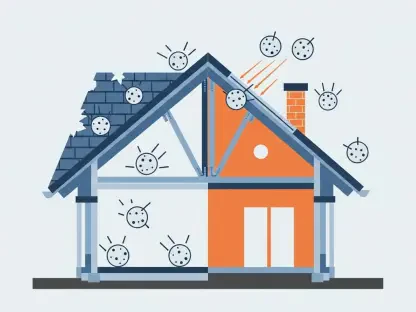In a world where climate change increasingly shapes the landscape of urban development, Simon Glairy stands out as a leader in risk management and AI-driven risk assessment, offering crucial insights into the profound challenges faced by housing developers. As he delves into the complexities of California and Arizona’s housing hurdles, his expertise sheds light on the intricate dance between nature and construction.
What are the main challenges California is facing in terms of finding safe places to build homes?
California is grappling with a delicate balancing act between addressing its housing shortage and the risks posed by wildfires and rising sea levels. The geography best suited for new development is often in high-risk wildfire zones, restricting growth possibilities. Finding locations that are safe yet accommodating for such a large number is a monumental challenge, compounded by climate factors.
How has the threat of wildfires impacted housing development in California? Can you provide specific examples of areas that have been affected?
Wildfires have drastically reshaped the landscape of housing development in California. Areas like the Sierra Nevada foothills, once affordable havens, have seen devastation due to fires. This has led to heightened caution in approving new developments in risky locales. Silverwood, a notable project, illustrates this challenge, as recent updates to fire hazard maps shifted it into a high-risk category, complicating development plans.
How significant is the threat of rising sea levels to the California coast and its housing options?
Rising sea levels pose a severe threat to California’s coastal regions, with millions of dollars in real estate at risk. The fear of erosion and the future prospect of inundation make these areas less appealing for new developments, affecting long-term housing availability and planning.
What steps has Governor Gavin Newsom taken to address California’s housing shortage? How has the “abundance” doctrine influenced housing development in the state?
Governor Newsom has taken proactive steps, like advocating for reduced bureaucratic barriers to housing development. The “abundance” doctrine aims to cut red tape, easing construction processes. New legislation has also been introduced to circumvent environmental laws, attempting to speed up housing production. These policies are designed to mitigate the shortage but must still navigate local resistance and environmental realities.
Why have some local governments in California resisted housing development projects?
Local governments often resist due to environmental concerns and the desire to preserve open spaces and farmlands. Community opposition also plays a significant role, with fears that new developments could exacerbate existing risks, particularly in wildfire-prone or evacuation-constricted areas.
How are economic pressures, like housing prices, influencing the state’s housing market? What are the current median housing prices in California, and how do they compare to other areas in the state?
Economic pressure from soaring housing prices is a critical driver of California’s housing market dynamics. With a median price of $900,000 statewide and $1.4 million in the Bay Area, affordability remains a substantial barrier for residents. These prices are remarkably higher compared to other parts of the country, yet they haven’t precipitated a construction surge due to persistent logistical and environmental challenges.
How have recent changes to the state’s wildfire hazard maps influenced new housing projects, like Silverwood?
The updated wildfire hazard maps have increased the areas classified as high-risk, directly impacting projects like Silverwood. Developers now face higher costs for fire-resistant features and may encounter challenges in securing insurance, which can deter potential buyers despite strong market demand.
What measures are developers taking to make homes more fire-resistant in high-risk areas?
Developers are incorporating non-flammable building materials, installing sprinkler systems, and using ember-resistant vents. Roads are being widened to prevent evacuation gridlock, and tempered glass is employed to withstand fires, all of which increase safety but also the cost of development in high-risk zones.
How are potential homeowners being affected by the increased fire risk, particularly regarding insurance options?
The escalating fire risk discourages insurers from providing coverage, complicating homeowners’ abilities to secure policies. Many must resort to state-run insurance options, which are often costlier and offer basic coverage, setting a barrier for would-be buyers who might otherwise invest in these high-risk areas.
In Arizona, how have groundwater restrictions affected housing development? How is the requirement for 100-year groundwater availability impacting new projects?
Arizona’s groundwater restrictions have essentially hit the pause button on over 150,000 planned housing units. With mandatory assurances of 100-year water availability, projects face constraints, delaying development and raising costs for obtaining water rights, further strangling the housing supply.
What solutions or strategies are developers in Arizona exploring to address the groundwater issue?
Developers are exploring creative solutions like repurposing lands for industrial use where water reliance is less stringent or relocating to regions with grandfathered water rights. Some cities are also investing in new infrastructure to import water, attempting to salvage development projects despite the tough restrictions.
How are evolving climate challenges influencing housing trends and prices in California and beyond?
Climate challenges are fostering a shift towards emphasizing resilience and sustainability in housing, directly affecting where and how homes are built. Rising costs for fire and water risk mitigation elevate home prices further, while regulatory changes attempt to alleviate some pressure, albeit unevenly across regions.
What might the long-term implications of these challenges be for the broader housing market in affected states?
These challenges could drastically redefine housing markets, potentially limiting growth in high-risk areas and shifting demand to safer regions. Long-term, we might see a push for more innovative building techniques and water management solutions, while insurance limitations and environmental policies evolve to better accommodate these emergent risks.









